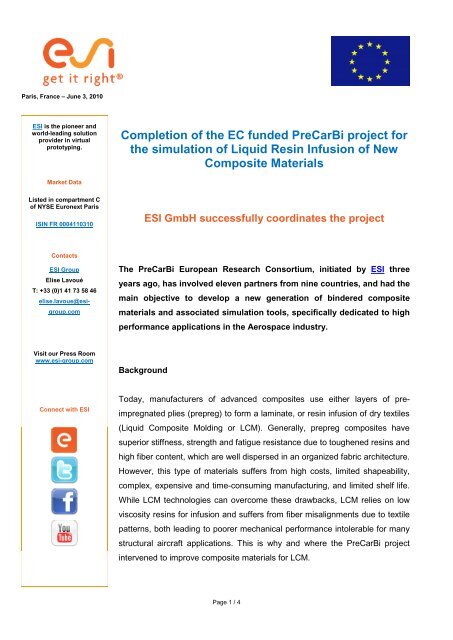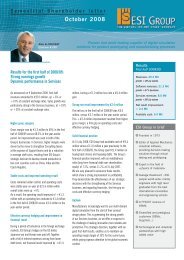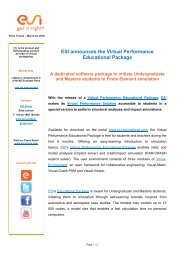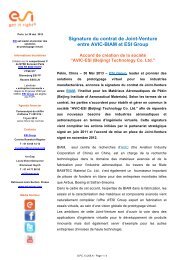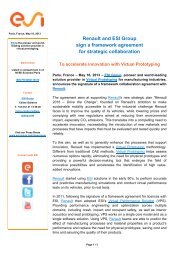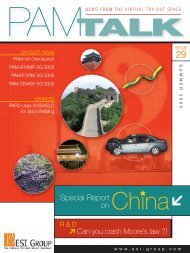PreCarBi consortium - ESI Group
PreCarBi consortium - ESI Group
PreCarBi consortium - ESI Group
Create successful ePaper yourself
Turn your PDF publications into a flip-book with our unique Google optimized e-Paper software.
Paris, France – June 3, 2010<br />
<strong>ESI</strong> is the pioneer and<br />
world-leading solution<br />
provider in virtual<br />
prototyping.<br />
Market Data<br />
Listed in compartment C<br />
of NYSE Euronext Paris<br />
ISIN FR 0004110310<br />
Contacts<br />
<strong>ESI</strong> <strong>Group</strong><br />
Elise Lavoué<br />
T: +33 (0)1 41 73 58 46<br />
elise.lavoue@esigroup.com<br />
Visit our Press Room<br />
www.esi-group.com<br />
Connect with <strong>ESI</strong><br />
Completion of the EC funded <strong>PreCarBi</strong> project for<br />
the simulation of Liquid Resin Infusion of New<br />
Composite Materials<br />
<strong>ESI</strong> GmbH successfully coordinates the project<br />
The <strong>PreCarBi</strong> European Research Consortium, initiated by <strong>ESI</strong> three<br />
years ago, has involved eleven partners from nine countries, and had the<br />
main objective to develop a new generation of bindered composite<br />
materials and associated simulation tools, specifically dedicated to high<br />
performance applications in the Aerospace industry.<br />
Background<br />
Today, manufacturers of advanced composites use either layers of preimpregnated<br />
plies (prepreg) to form a laminate, or resin infusion of dry textiles<br />
(Liquid Composite Molding or LCM). Generally, prepreg composites have<br />
superior stiffness, strength and fatigue resistance due to toughened resins and<br />
high fiber content, which are well dispersed in an organized fabric architecture.<br />
However, this type of materials suffers from high costs, limited shapeability,<br />
complex, expensive and time-consuming manufacturing, and limited shelf life.<br />
While LCM technologies can overcome these drawbacks, LCM relies on low<br />
viscosity resins for infusion and suffers from fiber misalignments due to textile<br />
patterns, both leading to poorer mechanical performance intolerable for many<br />
structural aircraft applications. This is why and where the <strong>PreCarBi</strong> project<br />
intervened to improve composite materials for LCM.<br />
Page 1 / 4
Project objectives<br />
The scientific aim of <strong>PreCarBi</strong> <strong>consortium</strong> was to develop new binder composite materials that<br />
allow pre-form designs to be manufactured and shaped under high temperature; or local tow<br />
reinforcement to be added under high temperature. This resulting research is considered an<br />
important contribution for advanced Liquid Resin Infusion (LRI) technologies to compete with<br />
expensive and complex pre-preg composite technologies.<br />
<strong>ESI</strong> GmbH was coordinator of this <strong>consortium</strong>. In addition, <strong>ESI</strong>’s major contribution to the project<br />
was forming, infusion and mechanical analysis of industrial aerospace applications manufacturing<br />
with the LRI technology.<br />
Description of the work<br />
The <strong>PreCarBi</strong> project took into account three principal materials:<br />
- New composite materials for bindered carbon yarns, developed by Tenax, in an iterative<br />
process to achieve the required performance;<br />
- Compatible resins, developed by Huntsman;<br />
- Converted new binder yarn composites into industrial preforms (Woven or Non-crimp<br />
Fabric) produced by Sigmatex and Airbus Operations GmbH.<br />
-<br />
Additional extensive materials characterization and testing work was performed by further research<br />
partners to assess and quantify improvements as the new materials were becoming available.<br />
From these efforts, <strong>ESI</strong> was then able to adapt PAM-QUIKFORM and PAM-RTM, simulation<br />
solutions for thermoforming and manufacturing of plastics and composites, to the industrial<br />
simulation of draping and LRI of binder yarn composites. Consequently, within the latter half of the<br />
project, industrial partners tested the new materials by applying them to selected industrial<br />
problems which are traditionally manufactured using only prepreg technologies. At this stage, a<br />
close collaboration between <strong>ESI</strong> and the industrial partners took place to help with numerical<br />
design and validate the industrial structures. Finally, the University of Patras worked on the<br />
development of cost analysis tools to help quantify the cost reductions over prepreg manufacturing.<br />
Page 2 / 4
Overall, the research <strong>consortium</strong>, coordinated by <strong>ESI</strong> GmbH, included two aircraft manufacturers:<br />
Airbus and Eurocopter; a tier one supplier: FACC; three materials manufacturers: Toho Tenax<br />
Europe, Sigmatex and Huntsman Advanced Materials (Switzerland) GmbH; a digital simulation<br />
software supplier: <strong>ESI</strong> <strong>Group</strong>; and four universities and research institutes: Cranfield University,<br />
IPM Latvia, University of Patras and SICOMP.<br />
Different draping and injection strategies were finally tested on three industrial demonstrator parts<br />
using the new materials and the LCM manufacturing feasibility analyzed during the research<br />
project.<br />
“Composites have become the material of choice for many advanced aircraft structural<br />
applications, but research is still required to identify more cost effective manufacturing and<br />
simulation tools to optimize their manufacturing and design”, said Dr. Anthony Pickett, Scientific<br />
Director at <strong>ESI</strong> GmbH. “The <strong>PreCarBi</strong> project has made a significant contribution to a new binder<br />
composite that will have a significant impact on the composite manufacturing industry and the<br />
aircraft manufacturing industry as a whole.”<br />
Coordinator: <strong>ESI</strong> GmbH<br />
Mergenthalerallee 15-21<br />
65760 Eschborn<br />
GERMANY<br />
Phone: +49 (0)61 96 9583 0<br />
Fax: +49 (0) 61 95 8311 1<br />
E-mail: Anthony.Pickett@esi-group.com<br />
The <strong>PreCarBi</strong> Team<br />
Page 3 / 4
For more <strong>ESI</strong> news, visit: http://www.esi-group.com/newsroom<br />
About <strong>ESI</strong> <strong>Group</strong><br />
<strong>ESI</strong> is a pioneer and world-leading solution provider in virtual prototyping that takes into account the physics of materials. <strong>ESI</strong> has<br />
developed an extensive suite of coherent, industry-oriented applications to realistically simulate a product’s behavior during testing, to<br />
fine-tune manufacturing processes in accordance with desired product performance, and to evaluate the environment’s impact on<br />
performance. <strong>ESI</strong>’s solutions fit into a single collaborative and open environment for End-to-End Virtual Prototyping, thus eliminating the<br />
need for physical prototypes during product development. The company employs over 750 high-level specialists worldwide covering<br />
more than 30 countries. <strong>ESI</strong> <strong>Group</strong> is listed in compartment C of NYSE Euronext Paris. For further information, visit www.esi-group.com.<br />
Page 4 / 4


